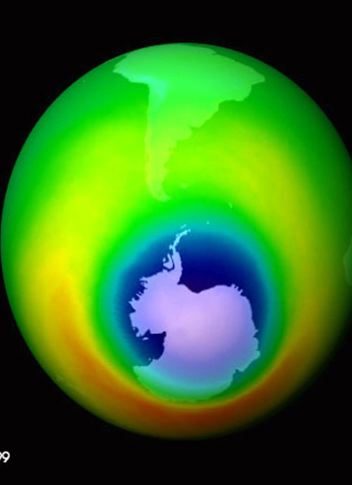
The impending CFC prohibition is the direct result of baseless fears concocted by some environmentalists and scientists. Their repetitious gloom and doom forecasts spurred ratification of the 1987 Montreal Protocol on Substances That Deplete the Ozone Layer. Led by the United States, 24 nations signed the spurious document during the Montreal gathering, and another 100 have climbed aboard as signatories in succeeding years. The protocol originally called for CFC production to be cut in half, but was later amended to require a complete phaseout of the substance by December 31, 1995 for “developed nations.”
The reason for the ban is the totally unfounded theory that the chlorine in CFCs escapes into the atmosphere, rises into the stratosphere, combines with the ozone found in those upper levels, and thereby removes the ozone shield needed to protect the earth and its inhabitants from harmful solar radiation. It all sounds reasonable, doesn’t it? And popular wisdom tells us that it couldn’t possibly be a completely screwball notion because some scientists, a bevy of environmentalists, and many politicians mouth it. But popular wisdom is dead wrong about ozone and CFCs.
Air-conditioning is actually a form of refrigeration. Enormously popular in America, it has led to cooler homes, workplaces, and automobiles. Remove airconditioning from the scene by making it too expensive and several areas of this nation could resemble ghost towns. Refrigeration has also made it possible for food producers to supply fresh and nutritious fruits, vegetables, dairy products, and meats everywhere. The largest of the giant supermarkets and the smallest of the general stores all use refrigeration to store and display the food we eat.
In addition, the ability to control temperatures has helped to make numerous medical procedures safer and more widely available. Preserving blood and transplantable organs for longer periods of time through refrigeration has enabled medical science to improve the quality of many lives.
All of this is the good news. The bad news is that the completely unnecessary government ban on the production of CFCs will change life in America in a dramatic way. And the freon found in your refrigerator and air conditioner are not the only chlorofluorocarbons that will be affected. There are literally hundreds of other useful applications for CFCs — in agriculture, manufacturing, medicine, insulation, and fire suppression. But our dictatorial federal government has decided that production of this beneficial, inexpensive, and useful manmade substance must cease.
Economic Consequences
In The High Cost of Cool, Ben Lieberman firmly argues that “the CFC phaseout may well be the single most expensive environmental measure taken to date.” One significant cost, he notes, will be the replacement or modification of $135 billion worth of air-conditioning equipment so that CFC replacements can be employed.
Lieberman reports that “most CFC replacements are new, and manufacturers are still near the bottom of the learning curve in making the massive technological changes necessary.” Yet industry is being forced to abandon what works and conduct “a multi-billion dollar field test of experimental equipment … at consumer expense.”
Before the phaseout began, the most common CFC refrigerants could be purchased for $1.00 per pound wholesale. Because of the scheduled phaseout, the CFC supply has dropped, as some producers no longer manufacture it. Today, Lieberman reports, the price of these CFC refrigerants has risen to over $8.00 per pound wholesale and twice that amount for retail users.
In the U.S. alone, 140 million vehicles have air conditioners. Recharging these systems with CFCs, a procedure costing only $20 to $40 as recently as 1991, has already soared beyond the $100 figure. Modifying a system to adapt to a non-CFC alternative will set a vehicle owner back an estimated $433. The auto industry has already spent huge amounts of money to redesign air conditioners, a cost that must be absorbed by consumers.
Replacements for CFCs have proven far less energy efficient. As a result, electricity use resulting from the ban will increase by billions of kilowatt hours, a cost which consumers will bear.
The cost for household refrigerators, which won’t last as long as those cooled by CFCs, will rise by at least $100. If a supermarket owner decides to retrofit his many cooling units, he will face a $45,000 bill. Restaurants will typically need to expend $1,000 per cooling unit. And all of this newly adapted equipment will require more servicing and will have a shorter life expectancy. The cost, of course, will be borne by consumers.
All of this expense would be worth every penny if the earth were really threatened by continued use of CFCs. But there is no scientific evidence whatsoever showing that the ban is necessary.
Science Versus Lies
On February 6, 1992, the U.S. Senate heard then-Senator Al Gore (D-TN) deliver a frightening message about ozone depletion. He asked his colleagues to add an amendment to a Senate bill addressing the need to reduce energy dependence. The Gore measure, which he introduced jointly with Senator John Chafee (R-RI), contained no mandates. It simply urged the President to advance the date for phasing out CFC production to the end of 1995, instead of the end of the year 2000 as originally planned.
In somber tones, Gore reminded his colleagues of previous fears about “the ozone hole over Antarctica,” and insisted that our nation faces “not only a long-term, critical threat to the global environment, but also an immediate, acute emergency threat.” He raved about “blind rabbits and blind salmon in the areas under the edge of the ozone hole in the Southern hemisphere,” and claimed that there would be “an additional 300,000 deaths from skin cancer in the United States as a result of ozone depletion over the next few decades.” He also linked ozone depletion to “extra cases of cataracts and blindness due to cataracts,” and to “damage to the human immune system….”
And what was the culprit behind this accelerating cataclysm? Gore pointed to CFCs, which he insisted were destroying the ozone layer above the earth. Gore angrily indicted President George Bush for ignoring an April 1991 report pointing to heightened ozone depletion. He maintained that the President was required under the provisions of the Clean Air Act to phase out ozone-depleting chemicals automatically whenever new scientific data showed that the problem had grown worse.
The full Senate passed the Gore-Chafee amendment by a vote of 96-0 that very day. No senator even took the floor to suggest caution about moving too fast with too little evidence to back up the fright-filled claims peddled by Gore and his allies.
The truth about CFCs and ozone depletion in the earth’s atmosphere is startlingly different from what Americans have generally been persuaded to swallow. It begins with the realization that easily detectable CFCs are the only man-made chemical mentioned in any scary scenario about ozone depletion. If CFCs are causing havoc to the ozone layer, there should be some data demonstrating their massive presence in the areas under question. But there is none.
For the past two and a half years, automotive air-conditioning engineer Bob Holzknecht has waged a crusade against the coming CFC ban. Out of his repair shop in Cocoa, Florida he runs the organization The Ozone Truth Squad (TOTS), and publishes bulletins in hopes of derailing the ban.
Holzknecht reported that in September 1991 NASA placed an unmanned satellite in orbit for the specific purpose of measuring man-made chemicals in the upper atmosphere. In February 1992, NASA officials held a press conference during which they aired predictions about imminent ozone depletion. Senators Gore and Chafee were delighted to reference those “scientific predictions” only two weeks later. NASA then launched the Atlantis space shuttle in March 1992, again to measure manmade chemicals in the upper atmosphere. Holzknecht summarized the NASA effort:
How much CFCs did they measure? A stone wall! They cannot admit that they have been wrong in so many press conferences for so many years by releasing the truth that only an infinitesimal quantity of CFCs ever rose up into the stratosphere. So they now claim no attempt was made to measure CFCs specifically and that neither mission had an instrument aboard to measure CFCs.
A few months later, according to Ben Lieberman’s Competitive Enterprise Institute report, NASA officials “admitted that their prediction was incorrect.” But, Lieberman noted, “the accelerated phaseout was unaffected.”
Holzknecht is only one of many who have addressed the repeated claims that the “ozone hole over Antarctica gets larger each year.” He explains:
Ozone is created by sunshine (energy rays from the sun) …. For several weeks each year, the natural tilt of the Earth’s axis shields the South Pole from its daily sunshine. During those weeks, very little new ozone gets created …. To attribute the “ozone hole” to escaping freon in Antarctica makes no sense; how many air conditioners and refrigerators exist on the whole continent? Zero!
But references to Antarctica’s annual ozone hole show up in the media every September — the end of the region’s long, dark winter.
Scientists Speak Out
In fact, there is no substantive scientific evidence showing that CFCs have affected the ozone in the upper levels of the earth’s atmosphere. Nor could there be any, according to scientists willing to take a firm stand on the matter. The late biologist Dr. Dixy Lee Ray spent a lifetime in science. Her credentials include service as chairman of the Atomic Energy Commission, Assistant Secretary of State in the Bureau of Oceans, and professor of zoology at the University of Washington. Late in life, she served a term as the elected governor of Washington. Before her death in 1993, she wrote two powerful books to debunk environmental hysteria: Trashing The Planet (1990) and Environmental Overkill (1995).
In Environmental Overkill, Dr. Ray explained what Al Gore and others refuse to consider:
It is the presence of oxygen in the high atmosphere and in the stratosphere that really protects us from ultraviolet radiation. In a very simplified manner, it works this way: Incoming ultraviolet radiation strikes and divides an oxygen molecule (O2). The two separate oxygen atoms are very reactive and quickly combine with other oxygen molecules to form ozone (O3). Ultraviolet energy is thereby absorbed and prevented from penetrating the earth’s surface. As long as there is sufficient oxygen in the stratosphere and as long as the sun puts out ultraviolet radiation at the right wavelength, ozone will be produced. Several tons of ozone are produced every second, mainly in that part of the stratosphere that is 10 to 40 kilometers above the earth’s surface.
The ozone molecules formed by this photochemical process become part of the “shield” that protects the earth from ultraviolet radiation. But ozone molecules are not long-lasting, since, unlike ordinary oxygen molecules, they are highly unstable. Any one of the oxygen atoms in an ozone molecule, as Dr. Ray noted, “can easily react with another ozone molecule to form three oxygen molecules or with other substances to form an oxygen molecule and some other oxygenated molecule.” Thus, through natural processes, ozone is constantly being created and destroyed.
One of the substances ozone can react with is chlorine monoxide. Any reputable scientist worried about the amount of chlorine monoxide in the upper atmosphere would logically seek to determine the source of the chlorine. Champions of the CFC ban claim that chlorine from the CFC molecule is the culprit, and that it is robbing the upper atmosphere of the ozone needed to protect mankind from the sun’s harmful rays.
There are at least three major problems with this theory. The first, as Dr. Ray explained, is that ozone is constantly being formed as a result of the blocking of ultraviolet light by oxygen molecules, and there is a plentiful supply of oxygen molecules in the upper atmosphere. Second, any chlorine detected in the upper atmosphere has likely come from the evaporation of sea water loaded with salt (sodium chloride) or from the millions of tons of hydrochloric acid spewed into the atmosphere by volcanic eruptions. And third, as Bob Holzknecht and others have reported, the amount of CFCs detected in the upper atmosphere is infinitesimal.
Dr. Ray also pointed out that “CFC molecules are four to eight times heavier than air.” And poking fun at the ridiculous claim that CFCs have caused a “hole in the ozone layer above Antarctica,” she wrote: “We do not know how these heavier-than-air molecules cross the equatorial counter currents to accumulate at the South Pole and do the most ozone damage there.” In point of fact, as Dr. Ray explained, “The regular, annual ozone ‘hole’ that appears over Antarctica was first measured in 1956-57, long before CFCs were in common use. The ‘hole’ appears at the end of the dark, cold Antarctic winter [a period of reduced incoming ultraviolet radiation], lasts about three to five weeks, and then disappears.”
Even though the theory that CFCs are destroying the earth’s ozone layer is seriously flawed, it is worthwhile asking how much ultraviolet radiation is reaching the earth’s surface compared to the past. Surely, if the earth’s oxygen/ozone protective shield against ultraviolet radiation is being compromised — whether due to CFCs alone or some combination of natural and/or man-made phenomena — more ultraviolet radiation should be reaching the earth’s surface. And yet, as Dr. Ray pointed out, citing studies by such scientific organizations as the National Center for Atmospheric Research and the National Cancer Institute, “ultraviolet radiation levels at the earth’s surface are going down, not up.” This simple fact speaks volumes, which perhaps explains why it has been all but ignored by the major media.
Other Voices
Dr. S. Fred Singer leads the Virginia-based Science and Environmental Policy Project. A former professor of environmental sciences at the University of Virginia, and the former director of the U.S. Commerce Department’s National Weather Satellite Center, he has offered numerous challenges to the claims of environmental extremists. In the 1992 anthology, Rational Readings on Environmental Concerns, Dr. Singer summed up his view concerning the reputed dangers from ozone holes:
The CFC/ozone theory is quite incomplete and cannot as yet be relied on to make predictions. The natural sources of stratospheric ozone have not yet been delineated, theoretically or experimentally. The Antarctic ozone hole may be ephemeral; it may be controlled by climate factors rather than by CFCs. The reported decline in global ozone may just be an artifact of the analysis. Even if real, its cause may be related to the declining strength of solar activity rather than to CFCs. The steady increase in malignant melanomas has been going on for at least fifty years and has nothing to do with ozone or CFCs. And the incidence of ordinary skin tumors has been greatly overstated.
The late Dr. Petr Beckmann, whose science newsletter Access to Energy regularly countered bogus scientific claims, also aggressively challenged Gore and his pseudo-scientific ilk. In the April 6, 1992 issue of THE NEW AMERICAN, Beckmann stated:
It is sunlight that produces the ozone in the first place. During the night, when there is no sun, the ozone recombines into oxygen …. There is no indication to what extent chlorine might compete with the mechanism of recombination. There is no indication that CFCs are as important as volcanic eruptions and other naturally occurring chlorines. The chlorine spewed out in the last eruption of Mount Pinatubo was 500 times larger than the annual production of CFCs in the whole world.
Dr. Hugh Ellsaesser is a scientist at California’s Lawrence Livermore National Laboratory. A former weather specialist for the U.S. Air Force, he holds three degrees in meteorology and is one our nation’s premier authorities on the topic. In the text of his wide-ranging speech appearing in the aforementioned Rational Readings on Environmental Concerns, he scoffed at the claims of ozone hole doomsayers:
For approximately 15 years now the ozone modelers have computed that the continued use of freons, or hydrochlorofluorocarbons, even at the unconstrained 1976 level … would produce a decrease in the ozone layer of less than 10 percent. In other words, the maximum computed effect would be comparable to that resulting from a displacement of 50 to 100 miles to the south [where more ultraviolet radiation would reach the earth]. I doubt that many of you consider that to be a very serious hazard.
In one of the bulletins he published for The Ozone Truth Squad, Bob Holzknecht reproduced two international pleas for sanity about ozone and CFCs — with the names of their hundreds of signers. They are:
- The October 1992 Heidelberg Appeal to Heads of States and Governments, signed by 425 members of the scientific and intellectual community from practically every nation on earth. Headquartered in Paris, this ad hoc group wants ecological proscriptions based “on scientific criteria and not on irrational preconceptions.” Its statement carries a warning “to the authorities in charge of our planet’s destiny against decisions which are supported by pseudoscientific arguments or false and nonrelevant data.”
- The document Seven Good Reasons to Overturn the Montreal Protocol, signed by over 100 international scientists, was sent to attendees of the November 1992 United Nations Program for the Environment meeting in Copenhagen, Denmark. The statement supplies supporting commentary to buttress each of the following declarations:
1. There is no long-term depletion of the ozone layer.
2. “Ozone holes” had been observed long before CFCs were in general use.
3. Sinks for CFCs exist in the atmosphere.
4. Chlorine of natural origins must be taken into account.
5. The danger represented by the increase of ultraviolet rays has been vastly overestimated.
6. The Montreal Protocol will be costly for the west and announces a certain death toll for Third World countries.
7. The unseemly haste to sign the Montreal Protocol was motivated by essentially political reasons.
Behind the Ban
Dr. S. Fred Singer is convinced that massive fraud is being perpetrated on the American people and the world. In his article, “My Adventures in the Ozone Layer” in Rational Readings, he expressed a willingness to excuse the wrong-headed urgings of many individuals who are sincerely concerned about what they perceive as a significant threat. Then he added:
But many of the [environmental] professionals share the same incentives as government bureaucrats: status, salaries, perks, and power. And then there are probably those with hidden agendas of their own — not just to “save the environment” but to change our economic system. The telltale signs are the attack on the corporation, the profit motive, and the new technologies. Some of these “coercive utopians” are socialists, some are technology-hating Luddites; most have a great desire to regulate — on as large a scale as possible.
While Dr. Singer has indicted only some members of the scientific and environmental community, we have no hesitation in swelling the indictment to include many politicians, mass media propagandists, academics, clergymen, and others whose motivation can hardly be less destructive of freedom.
Can America be brought to its knees through spurious environmental claims? Can our nation’s independence be destroyed by forcing us to submit to planned international controls over our daily activities? The abundant evidence suggests an affirmative response to both questions. If Americans allow such falsehoods to be used against us, we will soon lose all of our freedom, and our nation will become a mere province in a one-world socialist tyranny run by liars and despots.
Photo: AP Images



